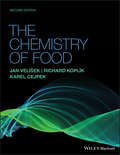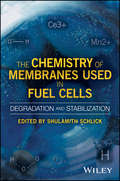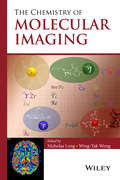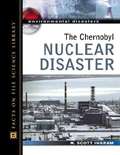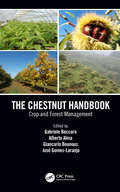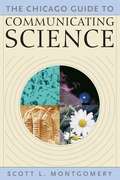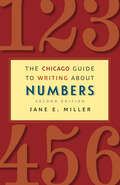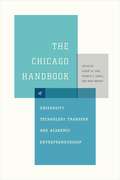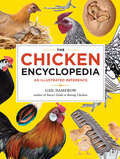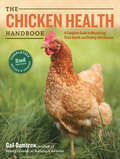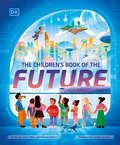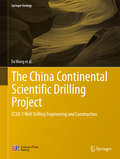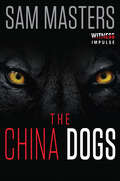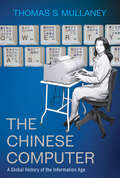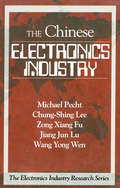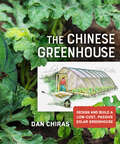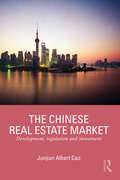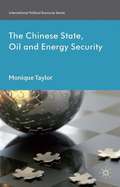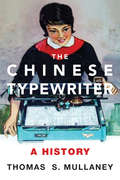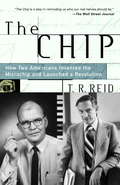- Table View
- List View
The Chemistry of Food
by Jan Velisek Richard Koplik Karel CejpekWiley's landmark food chemistry textbook that provides an all-in-one reference book, revised and updated The revised second edition of The Chemistry of Food provides a comprehensive overview of important compounds constituting of food and raw materials for food production. The authors highlight food’s structural features, chemical reactions, organoleptic properties, nutritional, and toxicological importance. The updated second edition reflects the thousands of new scientific papers concerning food chemistry and related disciplines that have been published since 2012. Recent discoveries deal with existing as well as new food constituents, their origin, reactivity, degradation, reactions with other compounds, organoleptic, biological, and other important properties. The second edition extends and supplements the current knowledge and presents new facts about chemistry, legislation, nutrition, and food safety. The main chapters of the book explore the chemical structure of substances and subchapters examine the properties or uses. This important resource: • Offers in a single volume an updated text dealing with food chemistry • Contains complete and fully up-to-date information on food chemistry, from structural features to applications • Features several visual aids including reaction schemes, diagrams and tables, and nearly 2,000 chemical structures • Written by internationally recognized authors on food chemistry Written for upper-level students, lecturers, researchers and the food industry, the revised second edition of The Chemistry of Food is a quick reference for almost anything food-related as pertains to its chemical properties and applications.
The Chemistry of Food Additives and Preservatives
by Titus A. MsagatiThe Chemistry of Food Additives and Preservatives is an up-to-date reference guide on the range of different types of additives (both natural and synthetic) used in the food industry today. It looks at the processes involved in inputting additives and preservatives to foods, and the mechanisms and methods used. The book contains full details about the chemistry of each major class of food additive, showing the reader not just what kind of additives are used and what their functions are, but also how they work and how they can have multiple functionalities. In addition, this book covers numerous new additives currently being introduced, and an explanation of how the quality of these is ascertained and how consumer safety is ensured.
The Chemistry of Membranes Used in Fuel Cells: Degradation and Stabilization
by Shulamith SchlickExamines the important topic of fuel cell science by way of combining membrane design, chemical degradation mechanisms, and stabilization strategies This book describes the mechanism of membrane degradation and stabilization, as well as the search for stable membranes that can be used in alkaline fuel cells. Arranged in ten chapters, the book presents detailed studies that can help readers understand the attack and degradation mechanisms of polymer membranes and mitigation strategies. Coverage starts from fundamentals and moves to different fuel cell membrane types and methods to profile and analyze them. The Chemistry of Membranes Used in Fuel Cells: Degradation and Stabilization features chapters on: Fuel Cell Fundamentals: The Evolution of Fuel Cells and their Components; Degradation Mechanism of Perfluorinated Membranes; Ranking the Stability of Perfluorinated Membranes Used in Fuel Cells to Attack by Hydroxyl Radicals; Stabilization Mechanism of Perfluorinated Membranes by Ce(III) and Mn(II); Hydrocarbon Proton Exchange Membranes; Stabilization of Perfluorinated Membranes Using Nanoparticle Additives; Degradation Mechanism in Aquivion Perfluorinated Membranes and Stabilization Strategies; Anion Exchange Membrane Fuel Cells: Synthesis and Stability; In-depth Profiling of Degradation Processes in Nafion Due to Pt Dissolution and Migration into the Membrane; and Quantum Mechanical Calculations of the Degradation Mechanism in Perfluorinated Membranes. Brings together aspects of membrane design, chemical degradation mechanisms and stabilization strategies Emphasizes chemistry of fuel cells, which is underemphasized in other books Includes discussion of fuel cell performance and behavior, analytical profiling methods, and quantum mechanical calculations The Chemistry of Membranes Used in Fuel Cells is an ideal book for polymer scientists, chemists, chemical engineers, electrochemists, material scientists, energy and electrical engineers, and physicists. It is also important for grad students studying advanced polymers and applications.
The Chemistry of Molecular Imaging
by Wing-Tak Wong Nicholas LongCovering all the fundamentals of modern imaging methodologies, including their techniques and application within medicine and industry, The Chemistry of Molecular Engineering focuses primarily on the chemistry of probes and imaging agents, as well as chemical methodology for labelling and bioconjugation. Written by an interdisciplinary team of experts, this book investigates the chemistry of molecular imaging and helps to educate non-chemists already involved in the area of molecular imaging. It addresses all the major modalities and techniques, such as MRI, positron emission tomography, single photon emission computed tomography, ultrasound, and fluorescence/optical imaging.
The Chemistry of Thermal Food Processing Procedures
by Maria Micali Salvatore Parisi Marco FiorinoThis Brief reviews thermal processes in the food industry - pasteurization, sterilization, UHT processes, and others. It evaluates the effects on a chemical level and possible failures from a safety viewpoint, and discusses in how far the effects can be predicted. In addition, historical preservation techniques - smoking, addition of natural additives, irradiation, etc. - are compared with current industrial systems, like fermentation, irradiation, addition of food-grade chemicals. The Brief critically discusses storage protocols - cooling, freezing, etc. - and packing systems (modified atmosphere technology, active and intelligent packaging). Can undesired chemical effects on the food products be predicted? This Brief elucidates on this important question. On that basis, new challenges, that currently arise in the food sector, can be approached.
The Chernobyl Nuclear Disaster
by Scott IngramThe world's worst nuclear power accident occurred on April 26, 1986, and had lasting repercussions in all areas of human life. This book details the events leading up to the Chernobyl nuclear power plant disaster, the causes of the explosion, and the ensuing fallout, both immediate and long-term. The social, economic, and political consequences of the disaster are discussed, and the catastrophic environmental and health effects on people living in the region are recounted in detail.
The Chestnut Handbook: Crop & Forest Management
by Gabriele Beccaro Alberto Alma Giancarlo Bounous Jose Carlos LaranjoChestnut Management and Production shares achievements in chestnut development and cultivation including information on sustainable planning and management of chestnut production from nursery to plantation, entomology, pathology, and ecosystem services. Cultivation techniques of Chinese, Japanese, and European chestnut species including hybrids are described containing information on over 550 local and commercial cultivars. Beautiful original handmade drawings and technical sheets facilitate accessibility and comprehension of information.
The Chicago Guide to Communicating Science
by Scott L. MontgomeryThis book offers detailed, practical advice on crafting every sort of scientific communication, from research papers and conference talks to review articles, interviews with the media, e-mail messages, and more.
The Chicago Guide to Writing about Numbers
by Jane E. MillerPeople who work well with numbers are often stymied by how to write about them. Those who don't often work with numbers have an even tougher time trying to put them into words. For instance, scientists and policy analysts learn to calculate and interpret numbers, but not how to explain them to a general audience. Students learn about gathering data and using statistical techniques, but not how to write about their results. And readers struggling to make sense of numerical information are often left confused by poor explanations. Many books elucidate the art of writing, but books on writing about numbers are nonexistent. Until now. Here, Jane Miller, an experienced research methods and statistics teacher, gives writers the assistance they need. The Chicago Guide to Writing about Numbers helps bridge the gap between good quantitative analysis and good expository writing. Field-tested with students and professionals alike, this book shows writers how to think about numbers during the writing process. Miller begins with twelve principles that lay the foundation for good writing about numbers. Conveyed with real-world examples, these principles help writers assess and evaluate the best strategy for representing numbers. She next discusses the fundamental tools for presenting numbers--tables, charts, examples, and analogies--and shows how to use these tools within the framework of the twelve principles to organize and write a complete paper. By providing basic guidelines for successfully using numbers in prose, The Chicago Guide to Writing about Numbers will help writers of all kinds clearly and effectively tell a story with numbers as evidence. Readers and writers everywhere will be grateful for this much-needed mentor.
The Chicago Guide to Writing about Numbers; Second Edition (Chicago Guides to Writing, Editing, and Publishing)
by Jane E. MillerEarning praise from scientists, journalists, faculty, and students, The Chicago Guide to Writing about Numbers has helped thousands of writers communicate data clearly and effectively. Its publication offered a much-needed bridge between good quantitative analysis and clear expository writing, using straightforward principles and efficient prose. With this new edition, Jane Miller draws on a decade of additional experience and research, expanding her advice on reaching everyday audiences and further integrating non-print formats. Miller, an experienced teacher of research methods, statistics, and research writing, opens by introducing a set of basic principles for writing about numbers, then presents a toolkit of techniques that can be applied to prose, tables, charts, and presentations. Throughout the book, she emphasizes flexibility, showing writers that different approaches work for different kinds of data and different types of audiences. The second edition adds a chapter on writing about numbers for lay audiences, explaining how to avoid overwhelming readers with jargon and technical issues. Also new is an appendix comparing the contents and formats of speeches, research posters, and papers, to teach writers how to create all three types of communication without starting each from scratch. An expanded companion website includes new multimedia resources such as slide shows and podcasts that illustrate the concepts and techniques, along with an updated study guide of problem sets and suggested course extensions. This continues to be the only book that brings together all the tasks that go into writing about numbers, integrating advice on finding data, calculating statistics, organizing ideas, designing tables and charts, and writing prose all in one volume. Field-tested with students and professionals alike, this holistic book is the go-to guide for everyone who writes or speaks about numbers.
The Chicago Handbook of University Technology Transfer and Academic Entrepreneurship
by Mike Wright Albert N. Link Donald S. SiegelAs state support and federal research funding dwindle, universities are increasingly viewing their intellectual property portfolios as lucrative sources of potential revenue Nearly all research universities now have a technology transfer office to manage their intellectual property, but many are struggling to navigate this new world of university-industry partnerships. Given the substantial investment in academic research and millions of dollars potentially at stake, identifying best practices in university technology transfer and academic entrepreneurship is of paramount importance. The Chicago Handbook of University Technology Transfer and Academic Entrepreneurship is the first definitive source to synthesize state-of-the-art research in this arena. Edited by three of the foremost experts in the field, the handbook presents evidence from entrepreneurs, administrators, regulators, and professors in numerous disciplines. Together they address the key managerial and policy implications through chapters on how to sustain successful research ventures, ways to stimulate academic entrepreneurship, maintain effective open innovation strategies, and improve the performance of university technology transfer offices. A broad and ambitious work, the handbook offers comprehensive coverage for universities of all types, allowing them to confidently handle technology commercialization and further cultivate innovation.
The Chicken Chick's Guide to Backyard Chickens: Simple Steps for Healthy, Happy Hens
by Kathy Shea MorminoThe Chicken Chick’s Guide to Backyard Chickens takes readers through all aspects of small flock care, including feeding, housing, chicken health, and more!Internationally known as The Chicken Chick, Kathy Shea Mormino brings an informative style and fresh perspective on raising backyard chickens to millions of fans around the world. An attorney by profession, Kathy is the founder and one-woman creative force behind her wildly popular and award-winning Facebook page and blog.Sharing her years of hard-earned experience and collaborations with poultry veterinarians, nutritionists, and professors, she provides simple steps to care for these uncommon pets with confidence. Kathy’s personality permeates the book as she guides newbie, veteran, and would-be backyard chickeneers alike in this fun and abundantly illustrated format that she has delivered on her blog for years.
The Chicken Encyclopedia: An Illustrated Reference
by Gail DamerowFrom addled to wind egg and crossed beak to zygote, the terminology of everything chicken is demystified in The Chicken Encyclopedia. Complete with breed descriptions, common medical concerns, and plenty of chicken trivia, this illustrated A-to-Z reference guide is both informative and entertaining. Covering tail types, breeding, molting, communication, and much more, Gail Damerow provides answers to all of your chicken questions and quandaries. Even seasoned chicken farmers are sure to discover new information about the multifaceted world of these fascinating birds.
The Chicken Health Handbook, 2nd Edition: A Complete Guide to Maximizing Flock Health and Dealing with Disease
by Gail DamerowHealthy chickens are happy chickens. This one-of-a-kind reference book covers the health problems that plague chickens of all breeds and ages. Practical charts identify common symptoms and causes of infection, while an alphabetic listing of diseases provides advice on treatment. You’ll find helpful descriptions of troublesome ailments of all types, from poor egg production to crooked toe syndrome. Practical remedies and gentle preventative care measures will help your beloved flock stay happy, healthy, and safe.
The Chief Shepherdess: Lessons in Life, Love and Farming
by Zoe Colville‘Funny, gutsy and heartfelt.’ Daily MailZoë Colville spent years in a fancy hair salon with a long list of clients, living on cigarettes, croissants, and a shoestring. It was everything she'd ever wanted. But when an unexpected and overwhelming loss caused her life to shift unexpectedly, she found herself on a different path. One where the only use for a hairdryer is warming new-born lambs; where the cycle of life on a farm gives new meaning on purpose, and where nature is both a strict teacher and a balm to soothe the pressures of everyday life.Zoë is now a full-time farmer, business owner and activist. In this memoir, she speaks vivaciously, humorously, and candidly about the lessons learned along the way, from mental health, social media and identity to surviving as an entrepreneur in a shifting economy. And through those lessons - in love, loss, and lambing - discovering something even more important: that it's always the right time to take a bold step and try something new.'I grab the motionless lamb, which is frighteningly slippery, and scramble on my feet, swinging its little body around to help it breathe. I see its chest move, then it sneezes and starts breathing. It's stunned by the delivery experience. As am I. I'm high on adrenaline. Tears are streaming down my face. I pop the lamb down on the ground and start frantically rubbing its tiny body... Looking back, I can see that this was one of the first moments of questioning whether I'm truly cut out for farming, realising that the answer might be... yes!'
The Children's Book of the Future
by Lavie Tidhar Richard WatsonA Children's Book of the Future is a narrative nonfiction book that will offer an inclusive and hopeful vision of the future, with a diverse, multicultural approach that will appeal to children of all backgrounds and further appeal to the foreign market audience.The book will consist of approximately eighteen chapters that each take inspiration from current scientific research. They'll present engaging, optimistic futures that could result from the real-world science, with insets delving into how that science works. The book will be highly illustrated throughout to make complex ideas more accessible, as well as to better depict the wondrous futures that could be ahead. There will also be a preface, afterword and an activities section.Some of the diverse visions explored include underwater cities; the solar system and space travel; green technologies and sustainability; robots and artificial intelligence; the future of cities; and much more!In short, the book sets out to reclaim the future for current and future generations of children.
The China Continental Scientific Drilling Project
by Wei Zhang Da Wang Xiaoxi Zhang Guolong Zhao Ruqiang Zuo Jialu Ni Gansheng Yang Jun Jia Kaihua Yang Yongyi Zhu Wenwei Xie Wenjian Zhu Peifeng Zhang Lasheng Fan Jianliang Ye Yongping WangThis book comprehensively introduces the drilling theory and practice behind CCSD-1 well drilling, the first stage of a key national scientific engineering project of China. In addition to access to variety of data and information accumulated decade during the project's decade-long operation, readers also gain insight into state-of-the-art techniques and most recent achievements in China's scientific drilling industry. Specifically, this work introduces the drilling engineering design, well site construction, and equipment and construction situation. It also provides a minute description on the new techniques that were developed for tackling the technical difficulties, expounds in detail the core drilling techniques for hard rock deep well, and treats diamond core drill bits, reaming drilling techniques in hard crystalline rocks, well-deviation control techniques for strong dipping strata, and much more. In summary, this book offers a valuable resource for engineers and technicians who engage in scientific drilling and a variety of resource drilling engineering; teachers and students who are interested in this field will also gain plentiful information. Prof. Da Wang, the former deputy director of China Geological Survey, was the director of the Engineering Centre, chief engineer and drill-site general director of China Continental Scientific Drilling Project.
The China Dogs
by Sam MastersCujo meets The Manchurian Candidate in this propulsive thriller set in Miami, in which a special ops soldier must uncover a deadly threat to national security: a nefarious plot using man’s best friend as a deadly weapon.In the blistering heat of Miami, fatal dog attacks are running at record levels. Swimmers, walkers, and homeowners have been shockingly savaged to death. The public is starting to panic. It seems the summer sun or some unknown virus is turning man’s best friend into his worst enemy.Lieutenant “Ghost” Walton shrugs it off as a freak coincidence.But when the body count rises, and the perimeter of blood and carnage widens across Miami-Dade county, the seasoned special ops detective with a nose for trouble senses there is something darker behind the pattern of violence, and he’s going to find out what it is. While his previous missions have prepared him for all kinds of danger, Ghost doesn’t anticipate falling hard for a beautiful and feisty out-of-towner with a murky past. Nor does he expect to stumble onto a plot that threatens national security . . . and now he must stop it before it’s too late.Full of gut-wrenching suspense, and twisting surprises, this gruesome thriller is perfect for fans of Randy Wayne White, Kathy Reich, James Grippando, and Joe Hill.
The Chinese Computer: A Global History of the Information Age
by Thomas S. MullaneyThe fascinating, untold story of how the Chinese language overcame unparalleled challenges and revolutionized the world of computing.A standard QWERTY keyboard has a few dozen keys. How can Chinese—a language with tens of thousands of characters and no alphabet—be input on such a device? In The Chinese Computer, Thomas S. Mullaney sets out to resolve this paradox, and in doing so, discovers that the key to this seemingly impossible riddle has given rise to a new epoch in the history of writing—a form of writing he calls &“hypography.&” Based on fifteen years of research, this pathbreaking history of the Chinese language charts the beginnings of electronic Chinese technology in the wake of World War II up through to its many iterations in the present day.Mullaney takes the reader back through the history and evolution of Chinese language computing technology, showing the development of electronic Chinese input methods—software programs that enable Chinese characters to be produced using alphanumeric symbols—and the profound impact they have had on the way Chinese is written. Along the way, Mullaney introduces a cast of brilliant and eccentric personalities drawn from the ranks of IBM, MIT, the CIA, the Pentagon, the Taiwanese military, and the highest rungs of mainland Chinese establishment, to name a few, and the unexpected roles they played in developing Chinese language computing. Finally, he shows how China and the non-Western world—because of the hypographic technologies they had to invent in order to join the personal computing revolution—&“saved&” the Western computer from its deep biases, enabling it to achieve a meaningful presence in markets outside of the Americas and Europe.An eminently engaging and artfully told history, The Chinese Computer is a must-read for anyone interested in how culture informs computing and how computing, in turn, shapes culture.
The Chinese Electronics Industry
by Michael Pecht Chung-Shing Lee Wang Yong Wen Zong Xiang Fu Jiang Jun LuThe Chinese Electronics Industry documents the technologies, capabilities, and infrastructure that has made China a major player in the Asian electronics industry. This book covers the major segments of China's electronics industry, including semiconductors, packaging, printed circuit boards, computer hardware and software, telecommunications, and electronic systems. In addition, this book examines the role of government, research organizations, educational institutions, and major companies in establishing an infrastructure where the industry can flourish. Specifically, this book will help readers:Comprehend the historical developments, current status, and future growth of China's electronics industryUnderstand the cultural, economic, and technological factors that drive and inhibit market access and success in ChinaMake decisions on strategic issues, such as market entry, establishing joint ventures or strategic alliances with Chinese electronics companies in order to access world's largest emerging marketFormulate strategy to cooperate and compete in the global electronics industry
The Chinese Greenhouse: Design and Build a Low-Cost, Passive Solar Greenhouse (Mother Earth News Books for Wiser Living)
by Dan Chiras“A prescription for survival in this gorgeously illustrated and accessible guide to the future of farming.” —Albert Bates, author of The Biochar SolutionGrow vegetables year-round in a greenhouse powered only by solar energy!Originally developed in China to feed millions, Chinese greenhouses are earth-sheltered, solar-heated, east-west oriented, intelligently glazed, and well-insulated. They have proven highly effective in growing warm-weather vegetables and fruits like green peppers and tomatoes in cold climates through fall, winter, and early spring using passive solar energy as the sole heat source.The Chinese Greenhouse is a full-color comprehensive guide to these passive solar greenhouses for self-sufficiency and growing year-round in soil or aquaponic grow beds with no additional heat. Coverage includes:How to design, build, and operate a Chinese greenhouseHow to improve performance via short-term and long-term heat bankingHow to provide additional heat to make your greenhouse operate even more effectivelyHow to cool the greenhouse during the summer.Become a more self-sufficient gardener, growing and harvesting a variety of fresh fruits and vegetables year-round, with your own Chinese greenhouse.“Wonderfully researched . . . brilliant.” —Jean-Martin Fortier, farmer and author of The Market Gardener, editor of Growers Magazine“Essential reading for pioneers of Chinese greenhouses.” —Pam Dawling, author of The Year-Round Hoophouse and Sustainable Market Farming“Every enthusiastic vegetable farmer dreams of this winter-growing miracle, and Dan shows how to do it.” —Shawna Coronado, author of 101 Organic Gardening Hacks
The Chinese Real Estate Market: Development, Regulation and Investment (Routledge International Real Estate Markets Series)
by Junjian Albert CaoThis is the first book to fully present, analyse and interpret the Chinese real estate market. Dr Junjian Albert Cao examines the Chinese real estate market’s growth trajectory, unique governance and factors affecting values and investment in the context of reforms, rapid economic growth and urbanization. The book provides essential insights into the institutional change surrounding the development of the property market, government intervention at local and national levels, taxes and other regulatory charges, and factors such as market practices, economic changes, government policies and social changes that affect the value of real estate. Furthermore, the book analyses academic and policy debates on issues such as: commercial property investment housing price inflation property rights protection affordable and social housing market practices and regulation environment and sustainability taxation property-led growth and the reliance of local economic growth on the property sector The book offers a comprehensive, in-depth and up-to-date account of the Chinese property market and presents a full assessment of the investment potential of Chinese real estate. It is a must read for students, academics and real estate professionals interested in this fascinating real estate market that has implications for Chinese and the world economies.
The Chinese State, Oil and Energy Security
by Monique TaylorMonique Taylor analyses the policy rationale and institutional underpinnings of China's state-led or neomercantilist oil strategy, and its development, set against the wider context of economic transformation as the country transitions from a centrally planned to market economy. The Chinese government's institutional capacities and policy instruments, namely the national oil companies (NOCs) and powerful central planning agencies, enable Beijing to pursue this state-led approach to energy security. Oil is a strategic sector in the Chinese economy and was never intended to 'grow out of the plan' and privatise, in contrast to the non-state sectors, due to its vital role in China's economic growth and development, and social stability. In tracing oil industry development in China from 1949 to the present day, an elite-driven account of institutional change is provided, showing that the party leadership has driven the reform process and remains the pivotal player in energy policymaking.
The Chinese Typewriter: A History (The\mit Press Ser.)
by Thomas S. MullaneyHow Chinese characters triumphed over the QWERTY keyboard and laid the foundation for China's information technology successes today.Chinese writing is character based, the one major world script that is neither alphabetic nor syllabic. Through the years, the Chinese written language encountered presumed alphabetic universalism in the form of Morse Code, Braille, stenography, Linotype, punch cards, word processing, and other systems developed with the Latin alphabet in mind. This book is about those encounters—in particular thousands of Chinese characters versus the typewriter and its QWERTY keyboard. Thomas Mullaney describes a fascinating series of experiments, prototypes, failures, and successes in the century-long quest for a workable Chinese typewriter. The earliest Chinese typewriters, Mullaney tells us, were figments of popular imagination, sensational accounts of twelve-foot keyboards with 5,000 keys. One of the first Chinese typewriters actually constructed was invented by a Christian missionary, who organized characters by common usage (but promoted the less-common characters for “Jesus" to the common usage level). Later came typewriters manufactured for use in Chinese offices, and typewriting schools that turned out trained “typewriter girls” and “typewriter boys.” Still later was the “Double Pigeon” typewriter produced by the Shanghai Calculator and Typewriter Factory, the typewriter of choice under Mao. Clerks and secretaries in this era experimented with alternative ways of organizing characters on their tray beds, inventing an input method that was the first instance of “predictive text.”Today, after more than a century of resistance against the alphabetic, not only have Chinese characters prevailed, they form the linguistic substrate of the vibrant world of Chinese information technology. The Chinese Typewriter, not just an “object history” but grappling with broad questions of technological change and global communication, shows how this happened.A Study of the Weatherhead East Asian InstituteColumbia University
The Chip: How Two Americans Invented the Microchip and Launched a Revolution
by T. R. ReidBarely fifty years ago a computer was a gargantuan, vastly expensive thing that only a handful of scientists had ever seen. The world's brightest engineers were stymied in their quest to make these machines small and affordable until the solution finally came from two ingenious young Americans. Jack Kilby and Robert Noyce hit upon the stunning discovery that would make possible the silicon microchip, a work that would ultimately earn Kilby the Nobel Prize for physics in 2000. In this completely revised and updated edition of The Chip, T. R. Reid tells the gripping adventure story of their invention and of its growth into a global information industry. This is the story of how the digital age began.
